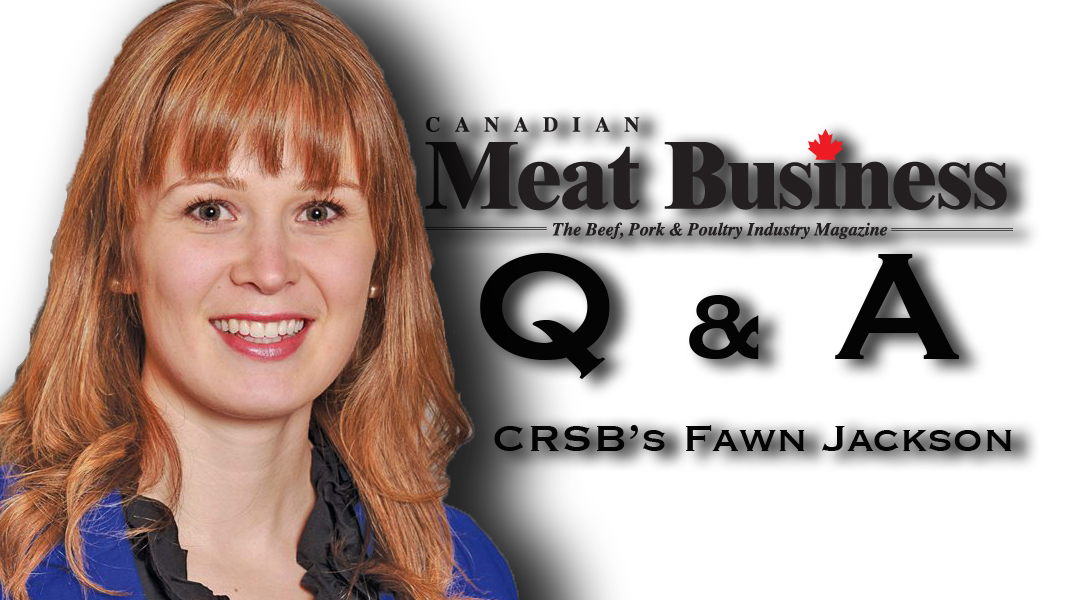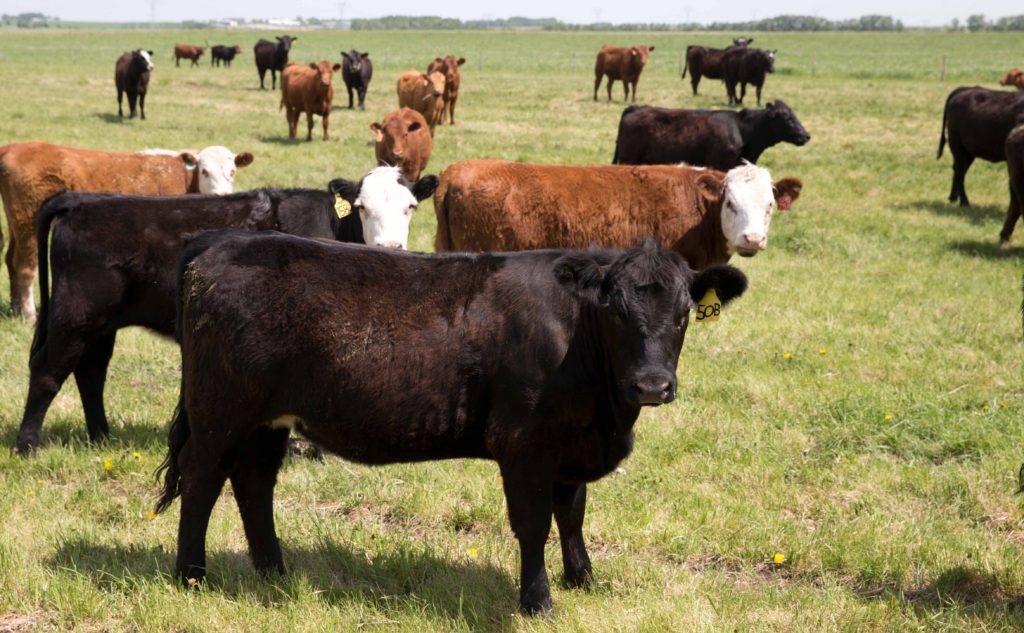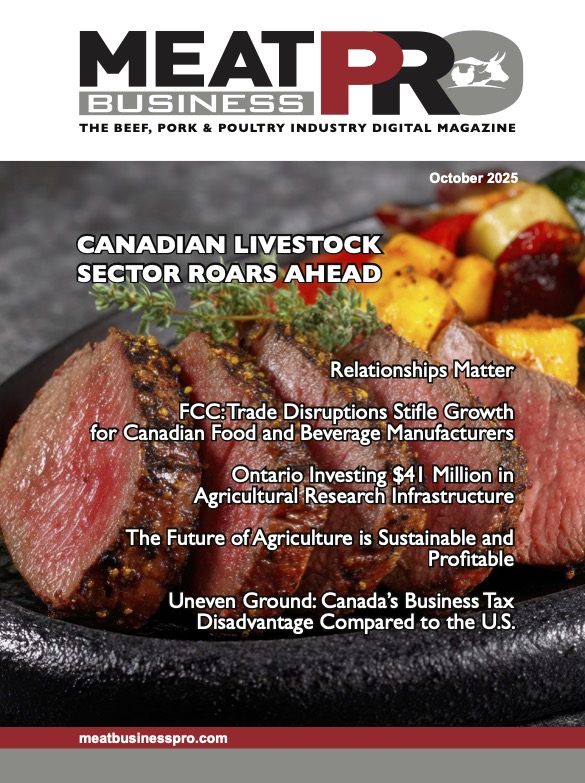Fawn Jackson Q&A: Sustainability is Really Coming Now

After five years of forums and metrics planning the Canadian Roundtable for Sustainable Beef (CRSB) is going live today in Edmonton and executive director, Fawn Jackson, couldn’t be more excited.
a Canadian Meat Business exclusive By Cam Patterson
With the concept of sustainability ringing in the ears of food industry pundits over the years,
along came the juggernaut that would be the Global Roundtable for Sustainable Beef (GRSB). Willed into existence in 2012 by a consortium of industry players like McDonald’s, Cargill and Elanco, the roundtable fostered a membership base spanning five constituency groups across the beef supply chain, including: producers and producer organizations; civil societies; retailers; processors; and the commerce sector. It would be another two years before the five core principles – natural resources, people and the community, animal health and welfare, food, and efficiency and innovation – would be announced at the inaugural conference in Sao Paulo, Brazil, defining the GRSB’s mandate. Since then the initiative faced the daunting task of raising awareness and cultivating a loyal stakeholder base across the globe.In her role as the Canadian Cattlemen’s Association’s (CCA) Manager of Environment and Sustainability, Fawn Jackson represents Canadian cattle producers, not only at the GRSB, but a host of environment committees. She has had a firsthand role in setting research and environment policy. Since 2014, she’s divided her time between her CCA role and that of Executive Director of the CRSB.
Canadian Meat Business (CMB) had the chance to talk sustainability with her.
“Everybody from producers to processors to retailers wants to have a more sustainable industry and recognize how to move that forward while establishing common ground that has led to a successful sustainability beef program”
– Fawn Jackson
CMB: Can you explain the three pillars that shape the CRSB program?
FJ: Certainly. First is Sustainability Benchmarking with our National Beef Accessibility Assessment, which assesses how the industry is doing with respect to sustainability awareness with a focus on social, economic and environment areas. For us, this year has really been about communicating those results, and identifying ways to achieve those goals and strategies that are written into that document.
Secondly, were working to develop the Certified Sustainable Beef Framework, which applies to on-site tracking of beef operations. This component has really been our big focus for 2017.
And thirdly is Project and Sustainability that works on supporting conservation and habitat preservation for sustainable beef.
CMB: Can you give me an example of the kind of project CRSB is involved with specifically for environment?
FJ: We have one project in Southern Alberta that focuses on collaborating with ranchers to better maintain and enhance the wildlife habitat overlapping with their range lands. We are working with a number of the CRSB members on this, namely; the Alberta Beef Producers, Alberta Conservation Association, MultiSAR (which is a habitat stewardship program that deals primarily with species at risk), the CCA, and Cows and Fish (a management society dedicated to riparian stewardship management).
The aim is to support producers in decision making or with projects on their operations that support habitat conservation for high risk species, typically wild life, reptiles, and so on. Essentially, biologists will go out to a beef operation that has voluntarily asked to participate in the project. They’ll do a range assessment, a riparian health assessment, and a species assessment, and then the team will analyze that information and determine if the producer has been doing well with respect to wildlife management. They may provide recommendations on how to improve problem areas and can also identify funding and/or alternative methods to implement proven conservation practices.
It really is about collaboration between the producer, who typically know their range lands extremely well, and those experts who can come in with help to advance conservation preservation on their operations.
CMB: What type of funding could producers seek to implement such recommendations?
FJ: One example would be Climate and Environment Change Canada. They typically provide funding for such programs.
CMB: It was big news when the five principles were announced in 2014. Now that the CRSB program is close to practical application, do those principles still anchor the benchmarks for the framework?
FJ: Yes, having those five guiding principles of sustainable beef really does act as the guiding posts of everything we do within the CRSB. For example, having that broad definition of sustainability is extremely important in establishing consistency when we’re considering the work the Colombians are doing, or the Brazilians, Americans, Australians, or any participating country for that matter. I really do feel the GRSB has been very supportive in recognizing that one production practice doesn’t necessarily apply to every region around the globe. Right from the start they were keen to make sure that initiatives were outcome based, and appropriate for the regions in which they were developed. Allowing each of the regions this kind of flexibility to achieve the five principles is one of the primary reasons this global initiative has been so successfully received.
For example, Columbia was just approved last year. Paraguay and Uruguay are doing some really fantastic work. They’re on a trajectory to have a sustainability initiative and maybe even an official roundtable. There are discussions now in China and Africa. It has been really amazing in how this initiative has grown globally. It brings so many different stakeholders together that it is really going to strengthen the global beef industry on a whole.
CMB: Have you had the opportunity to visit other participating countries to get a sense of how their managing the five principles?
FJ: Yes. I’ve been able to work with various regions and that has been so valuable to see how they approach the same goals. And as much as they may implore differing methods there are also many similarities, so you gain a lot of peripheral knowledge that directly adds to your own success.
CMB: What has been done to expand public awareness?
FJ: Social media, forums, conventions have all really helped because there are a lot of different sides to the sustainability conversation. That said, we are continually driving our initiatives forward while we strive to more effectively talk about how our industry is achieving the sustainability objectives.
CMB: The last public consultation was this past summer. How would you define the value such forums contribute to framework development?
FJ: Invaluable to be honest. Throughout the process of designing the certifiable beef framework, CRSB has had three committees that worked on development; Indicator, Verification, and the Communications and Marketing committee. Public consultations were an integral part of that process, and were so fundamental in establishing a nationally unified sustainability framework. We had excellent public engagement and the commentary definitely moved us forward. This last round we had some 250 comments that we took into consideration, determined the value of instituting those changes, and in some cases defended reasoning for why some indicators were listed as they were. But getting that input really contributed to us achieving a certifiable beef framework that is as close to perfect as I feel we can get.
CMB: What are the components to the framework exactly?
FJ: There are four main parts to the framework: The indicators of course – what would you measure during beef operations to verify sustainability. The assurance protocol – what does the certification process look like. Track back – how do you track that product through the supply chain. And the communication guide part as well.
CMB: How would you describe CRSB’s role with respect to data management and tracking?
FJ: CRSB is more the framework holder and then from there onus is on the supply chains to manage their tracking data. There are certification bodies that approve and track that information, but that is not under the proviso of the CRSB. We stipulate what information has to be tracked but how producers and processors choose to do that is up to them.
CMB: Is participation voluntary?
FJ: Yes, within Canada, participation is voluntary and purposeful. We understand the program will work for some producers and not for others. Yet we do have a variety of ways for producers and processors to engage in the program because it is important to us that we continue to drive forward our mission to achieving sustainable beef in Canada.
CMB: When is the official launch and what is it going to entail?
FJ: We’re going to launch during our fall AGM in Edmonton this December. There will be a launch event on the 7th from 3:00 pm-7:00 pm.
CMB: Does it feel like a long time coming for you?
FJ: In all actuality, given that we’ve developed a comprehensive program like this that is the first of its kind in the world, it was done relatively fast. I think this really exemplifies the dedication of the committees and also the broad membership, and is truly admirable for the CRSB to take leadership in this area. Everybody from producers to processors to retailers wants to have a more sustainable industry and recognize how to move that forward while establishing common ground that has led to a successful sustainability beef program. I’m very proud of the work we’ve done.
a Canadian Meat Business exclusive By Cam Patterson












